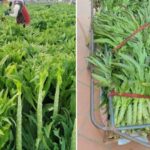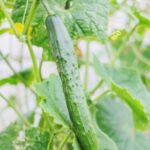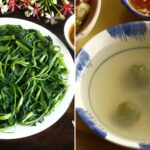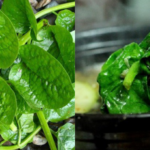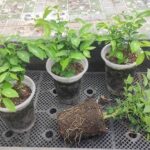Insects and pests can easily attack fruits and vegetables, so many farmers use pesticides to ensure a good harvest. Additionally, traders may also use harmful chemicals to keep produce looking fresh and pristine for longer, especially during transportation and before they reach the market.
This has caused concern among consumers about the quality and safety of the fruits and vegetables they consume daily.
5 Types of Fruits and Vegetables That Are More Likely to Contain Pesticide Residues
- Water Spinach
Water spinach is a popular vegetable in Vietnam, often served boiled or as a sour soup during the summer. However, not many people are aware that water spinach is at a higher risk of containing pesticide residues due to its rapid growth rate. It only takes a few days for the vegetable to reach the desired length for harvest, and during this time, any pesticides applied may not have had enough time to break down completely.
When preparing water spinach, it is recommended to rinse the vegetable thoroughly under running water to remove as many impurities as possible. If the spinach emits an unusual or pungent odor, it is best to discard it.
- Cucumber
Cucumbers are high in water content and low in calories, making them a refreshing snack or a versatile ingredient in various dishes. However, it is important to be cautious when purchasing cucumbers as they can easily retain harmful substances.
To minimize any potential risks, thoroughly wash cucumbers under running water and consider soaking them in salted water for a few minutes before consumption. Peeling the cucumber’s skin can also reduce the intake of unwanted chemicals that may be present on the surface.
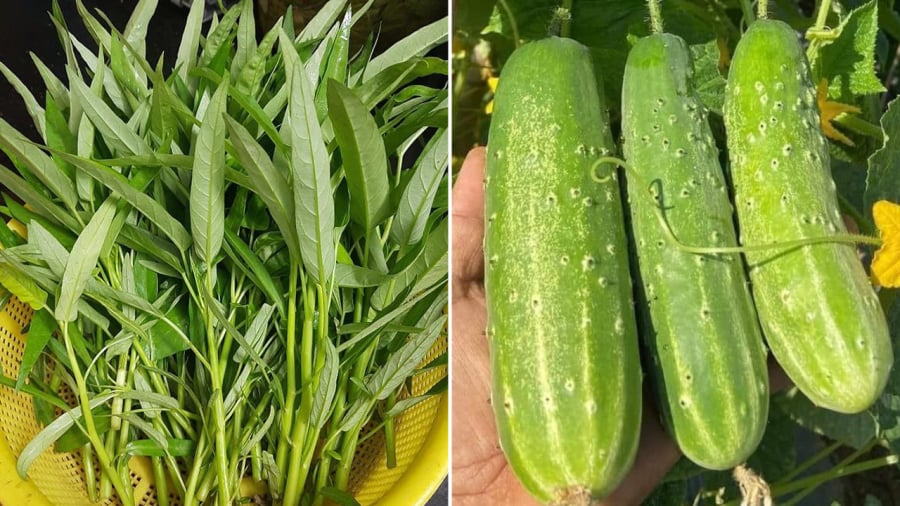
- Cauliflower
Cauliflower, and cruciferous vegetables in general, are challenging to clean thoroughly due to their intricate structure. Additionally, cauliflower is prone to bruising and difficult to store, increasing the likelihood of parasite infestation or chemical preservation.
When purchasing cauliflower, avoid heads with black spots, indicating spoilage and bacterial infection. It is advisable to break the cauliflower into smaller florets and rinse them thoroughly, paying attention to the crevices. Briefly dipping the vegetable in hot water before cooking can help eliminate any harmful substances.
- Napa Cabbage
Contrary to popular belief, napa cabbage is not as clean as it seems. It is susceptible to pesticide residue, and while some may think that peeling off the outer leaves is sufficient, the inner layers can still be affected by chemicals. During the growth period, farmers may apply pesticides multiple times, making it challenging to ensure that the inner layers are entirely free from these substances.
To properly clean napa cabbage, separate the leaves and rinse them thoroughly. Soaking the cabbage in salted water for a few minutes, followed by a rinse in clean water, can help reduce any potential risks.
- Tomatoes
The market offers a diverse range of tomatoes in terms of color, shape, and size. To achieve abundant yields and minimize pest damage, farmers may use growth regulators, catalysts, and pesticides. Tomatoes with angular shapes or unusual curves may indicate the use of growth regulators, while those with red exteriors but green interiors could be a result of ripening agents.
When buying tomatoes, thoroughly wash them, paying close attention to the stem area, as this is where pesticide residues are most likely to accumulate.
4 Types of Fruits and Vegetables That Are Generally Safer
- Avocados
Avocados are relatively safe and unlikely to contain pesticide residues. Their thick skin acts as a natural barrier, protecting the inner flesh from external contaminants.
- Onions
Onions possess natural compounds that help ward off pests and diseases. Consequently, farmers rarely need to apply pesticides to this particular crop.
- Pineapples
Pineapples have a protective outer layer of sharp spikes, naturally safeguarding the fruit from external intruders. Additionally, the practice of peeling away a thick layer of skin before consumption further reduces the chances of ingesting any unwanted substances that may be present on the fruit’s surface.
- Mangoes
Mangoes, with their thick skin, provide a similar protective barrier against external contaminants. Moreover, mango trees are naturally more resistant to pests and diseases, reducing the need for excessive pesticide use during cultivation.
In conclusion, while the presence of pesticides in our food is a valid concern, being informed about the types of produce that are more susceptible to chemical residues can help consumers make wiser choices and take the necessary precautions to ensure their health and well-being.

























